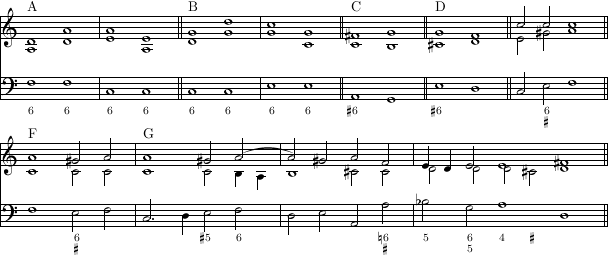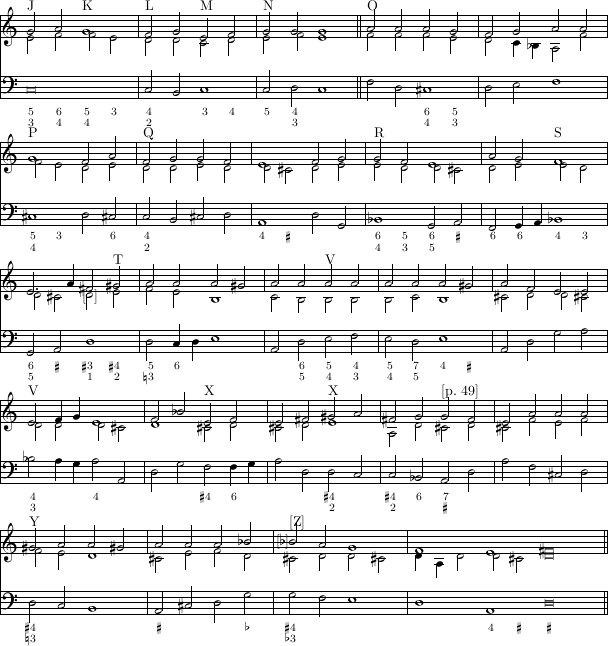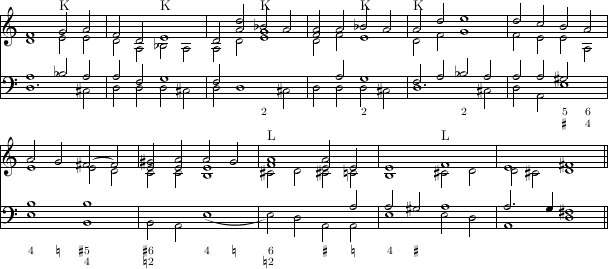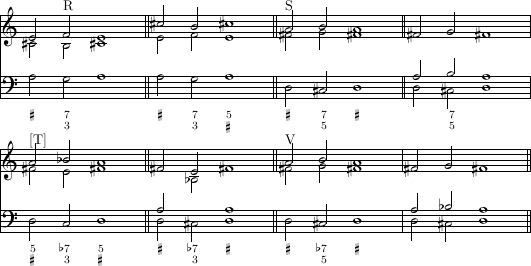
|
[p. 42] Daß aber außer der falschen Octaven sonst auf ein andere zuläßliche
Weis in einem Concent sich mi contra fa befindet, wird solcher Grieff
chromatisch gemacht, weilen gemeiniglich darbeÿ fast jederzeit ein oder ander
Clavis chromatica frembde Diesis oder Semitonium gebraucht wird.
|
Once there is mi contra fa in some permissible way in a chord, except
the octave, this Grieff becomes chromatic since in such case one
normally uses almost always one chromatic touch foreign diesis or
halfnote.
|
Dans un cas toléré, quand on trouve mi contra fa dans un accord, à
l'exception de l'octave, ce Grieff devient chromatique parce que dans
ce cas, habituellement, on a presque toujours besoin d'une touche chromatique
étrangère, dièse ou demi-ton.
| |
Ein jeder Grieff, in welchen sich ohn dem ein falsche Dissonanz gegen den Baß
einfindet, ist für sich selbst chromatisch, in andern Grieff aber, wo zwar
gegen den Baß kein falsches Intervallum gebraucht wird, kann so offt der
Concent für chromatisch zwischen den obern und mittern Stimmen gehalten werden,
als beÿ den darinn begrieffenen unterschiedlichen Intervallen die zweÿ
contrarij Termini oder Worter major und minor zu finden seÿn, wie in
nachfolgenden Examine eines jeden Concenten mit mehrern klahrlich außzunehmen.
|
Each Grieff in which already a false dissonance against the bass is to
be found, is by itself chromatic, but in other Grieff whithout a false
interval against the bass the chord can be considered as chromatic between the
upper and inner voices once at the intervals contained therein the two opposed
terms or words major and minor are to be found, as to be seen clearly in the
following examination of each chord.
|
Chaque Grieff dans lequel se trouve déjà une fausse dissonance contre
la basse est chromatique de soi même; mais dans d'autres Grieff, dans
lesquelles n'est utilisé aucun faux intervalle contre la basse, l'accord peut
être consideré comme chromatique entre les voix supérieures ou
intérieures, quand les termini ou mots contraires majeurs et
mineurs se trouvent inclus dans les intervalles, ainsi qu'on va le voir
clairement au cours de l'examen de tous les accords qui suit.
| |
Ordinarius oder ordinari Concent kann nichts chromatisch an sich haben, weil er
der rein und vollkommenste ist, welcher weder gegen den Baß, noch zwischen den
andern Stimmen kein einziges falsches Intervallum gedultet.
|
The common chord cannot have anything chromatic because it is the purest
and most perfect, which does not permit any false intervals neither against the
bass nor between other voices.
|
L'accord ordinaire ne peut contenir aucun chromatisme parce qu'il est le
plus pur et le plus parfait; il ne tolère aucun faux intervalle ni contre la
basse ni entres les autres voix.
| |
Sextilis, der Grieff, so wir sextilis nenen, ist diatonisch oder natürlich,
wann beede die Terz und die Sext gleich miteinander majores, A, oder zugleich
miteinander minores, B, seynd.
|
Sextilis, the Grieff which we call sextilis, is
diatonic or natural if both third and sixth are major at the same time, A, or
minor at the sime time, B.
|
Le sextilis, le Grieff que nous appellons sextilis,
est diatonique ou naturel quand la tierce et la sixte sont majeures en même
temps, A, ou mineures en même temps, B.
| |
Wann aber die Terz minor ist, die Sext aber major, so ist es chromatisch, dann
die beede obere Stimen machen gegeneinander entweder ein falsche große Quart,
C, oder ein kleine falsche Quint, D;
|
But when the third is minor and the sixt major, then it is chromatic since the
two upper voices mutually form either a false large fourth, C, or a false small
fifth, D.
|
Mais quand la tierce est mineure et la sixte majeure, l'accord est alors
chromatique, parce que les deux voix supérieures forment entres elles soit
une grande fausse quarte, C, soit une petite fausse quinte D.
| |
dahero es sehr fein lauthen thut, wann die Sext major aufwerts, die Terz minor
aber abwerts in folgenden Grieff steiget, C, D.
|
thus, it sounds very nice if the major sixth ascends and the minor third
descends in the following grip, C, D.
|
donc, cela sonne très bien, si la sixte majeure monte et la tierce mineure
descend dans l'accord suivant,.
| |
Noch seltzamer und chromatischer lautet der Sextil, wann in Wiederspiel die
Terz major und die Sext minor gegrieffen wird, dann diese zweÿ Intervalla
verursachen zwischen den obern Stimen entweder ein kleine falsche Quart, E,
oder ein falsche große Quint, F.
|
Even stranger and more chromatic sounds the sextil when one plays
together the major third and the minor sixth, then these two intervals cause
either a small false fourth, E, or a false large fifth, F, between the upper
voices.
|
Le sextil sonne de manière encore plus étrange et chromatique quand la
tierce majeure et la sixte mineure sont jouées ensemble; dans ce cas, les deux
intervalles forment soit une petite fausse quarte, E, soit une fausse grande
quinte, F, entre les voix supérieures.
| |
Dahero soll die Terz major in folgenden Grieff sich hinauf gradatim begeben,
die Sext minor aber entweder still liegen bleiben, E, F, oder umb zweÿ
diminuirende Noten gradatim absteigen, G.
|
Thus, in the following Grieff the major third should ascend gradually
and the minor sixth should either stay, E, F, or descend gradually in two
diminuished notes, G.
|
Donc, la tierce majeure doit monter dans le Grieff suivant, mais la
sixte mineure peut soit rester sur la même note, E, F, soit descendre
conjointement en deux notes diminuées, G.
|
|

|
Doch wann mehr Sextil oder Sexten Concenten nacheinander komen, so gehet man
nicht so genau, auf die Salvierung der gemelten chromatischen Terzen und
Sexten, dann die Noth und Harmonie fordert offt, daß die Terzen und Sexten
majores absteigen, die minores aber herentgegen aufwerts sich bewegen, wie in
denen Exempeln, H.
|
But when more sextil or sixth chords follow each other, one does not
pay so much attention on the resolution of the mentioned thirds and sixths
because the necessity and harmony demands often that the major thirds and sixth
descend while the minor move upwards, as in the examples, H.
|
Mais quand plusieurs sextil ou accords de sixte s'enchaînent, on n'est
plus vraiment obligé de résoudre les tierces et sixtes chromatiques
mentionnées, parce que le besoin et l'harmonie demandent souvent que les
tierces et sixtes majeures descendent, alors que les mineures montent, comme
dans les exemples, H.
| |
Exempeln des unterschiedlichen Sextilis.
|
Examples of the different sextilis.
|
Exemples de differents sextilis .
|

|
[p. 45] Semisextilis, wann zugleich die Quint just darbeÿ ist, wie aus
gemein supponiert, beede aber, Intervalla der Terz und der Sext, entweder
zugleich major, A, oder zugleich minor seynd, B, (die man mit 4 oder mehr
Stimmen schlagt) kombt nichts chromatisch heraus.
|
Semisextilis, when there is also the right fifth, as commonly assumed,
but both intervals, the third and the sixt, are either both major, A, or both
minor, B, which one plays with four or more voices, anything chromatic
will come out.
|
Quand la quinte juste est entendue dans le semisextilis, comme on le
suppose normalement, mais que les deux intervalles, la tierce et la sixte, sont
soit en même temps majeures, A, soit en même temps mineures, B, quand
joue à quarte voix ou plus, il n'en sortira rien de chromatique.
| |
Findet sich aber, daß darbeÿ die Terz minor, und die Sext major ist, C, oder
das Wiederspill, nemblich, daß die Terz major und die Sext minor geschlagen
wird, D, so machen zwischen denen obern Stimen die Terz und die Sext ienen
chromatischen Effect, den wir oben in solchen Fall bey den Sextil gemeldet
haben, dahero die Terz minor gern absteiget, C, die Terz major gern
auffsteiget, Exempel D.
|
But should it happen that the third is minor and the sixth is major therein,
C, or the opposite, namely that one plays the major third and the minor sixth,
D, then the third and the sixth make that chromatic effext between the upper
voices which we have mentioned above with the sextil, and then, the
minor third likes to descend, C, and the major third likes to ascend,
example D.
|
Mais quand on y trouve la tierce soit mineure et la sixte [soit] majeure, C,
ou au contraire, quand on joue la tierce majeure et la sixte
mineure, D, la tierce et la sixte font un effet chromatique entre les voix
supérieures, comme mentionné ci-dessus avec le sextil, et alors, il
est préférable que la tierce mineure descende, C, et que la tierce majeure
monte, exemple D.
|

|
Ist aber im Semisextil die Quint falsch, so ist dieselbe ohne dem und für sich
selbst gegen den Baß chromatisch, wie an gehörigen Orth gesagt wird.
|
But when the fifth in the semisextil is false, then it is anyway and
by itself chromatic against the bass, as will be told at the corresponding
place.
|
Mais quand dans le semisextil, la quinte est fausse, elle est de toute
façon par elle-même chromatique contre la basse, comme on le dira à l'endroit
correspondant.
| |
Beÿ den Concenten, in welchen die gerechte gute Quart sich befindet, als
nemblich 1mo beÿ der sießen Quart Quarta consonans genant J, 2do beÿ
der obern gebundenen Quart Quarta supersÿncopata K, 3tio beÿ der unten
[p. 47] gebundenen Quart Quarta subsÿncopata L, [ist kein
chromatischer Effect.]
|
In the chords where one finds the good and right fourth, namly 1st with the
sweet four named quarta consonans, 2nd with the upper tied fourth
quarta supersyncopata K, 3rd with the lower tied fourth quarta
subsyncopata L, [there is no chromatic effect.]
|
Dans les accords où se trouve la quarte bonne et juste, c'est-à-dire 1.avec
la quarte douce appellée quarta consonans J, 2. avec la quarte
liée par le haut quarta supersyncopata K, 3. avec la quarte liée
par le bas quarta subsyncopata L, [il n'y a pas d'effect chromatique.]
| |
Beÿ der welschen irregular Quart Quarta Italica nota, wann nit beÿ
dieser [eine] Sext major mit Tertia minor sich gesellet, ist kein falsches
chromatisches Intervallum zu erwarten, da aber an stat der guten die kleine
oder große falsche Quart genommen wird, wie wir schon an gehörigen Örthern
gemeldet haben, so verursachet jederzeit solche falsche Quart gegen den Baß
selbsten chromatischen Effect.
|
With the "welsh" irregular fourth quarta italica note, if no major
sixt and minor third is joining it, no false chromatic interval is to be
expected, but when the small or large false fourth is taken instead of the good
one, as we have already mentioned at corresponding places, this false fourth is
always causing the chromatic effect against the bass.
|
Quand est indiquée la quarte welche irregulière quarta italica,
on n'entend aucun intervalle faussement chromatique si celle-ci n'est
jointe par aucune sixte majeure et tierce mineure; mais quand la fausse
quarte, petite ou grande, est mise à la place de la bonne, comme déjà
mentionné aux endroits correspondants, cette fausse quarte provoque toujours
un effect chromatique contre la basse.
| |
Und zwar die kleine falsche Quart, dann sie alß wie sieße Quart passiren will,
macht ein chromatisches allein gegen den Baß, O.
|
When the small false fourth passes as a sweet fourth, it allone makes a
chromatic [effect] against the bass, O.
|
Quand la petite fausse quarte passe comme la quarte douce, elle fait à
elle seule un [effet] chromatique contre la basse, O.
| |
Da sie aber mit der falschen Quint zugleich als wie Quarta supersÿncopata oder
oben gebundene Quart genommen wird, ist das chromatisch gegen den Baß
verdoppelt, P.
|
But when it is taken together with the false fifth as quarta
supersyncopata or upper tied fourth, that is chromatically doubled against
the bass, P.
|
Mais quand elle est jouée simultanément avec la fausse quinte comme quarta
supersyncopata ou quarte liée par le haut, elle provoque un double
chromatisme contre la basse, P.
| |
Wird sie von unten sÿncopirt, [Q] ist sie gegen den Baß einschichtig
chromatisch, da sie als sieße, R, oder oben sÿncopirte, S, oder als
durchgehende, T, oder als welsche, V, oder als rechter gemeiner Tritonus, X,
gebraucht wird, und zwar bestehet der chromatisch falsche Effect gegen den Baß
selbsten.
|
When it is tied below, [Q] then it is simply chromatic against the bass, as it
is used as sweet, R, or upper tied, S, or as passing, T, or as "welsh" fourth,
V, or as ordinary tritonus, X, namely the chromatic effect against the
bass is contained in itself.
|
Quand elle est liée par le bas, [Q] elle est simplement chromatique contre la
basse, ainsi qu'on l'utilise en tant que quarte douce, R, ou en tant que quarte
lièe par le haut, S, ou passante, T, ou welche, T, ou en tant que
tritonus ordinaire, X; l'effet chromatique contre la basse est contenu
en lui-même.
| |
Nimbt man aber zum Tritonum noch ein Terz minor, wie bißweilen
geschehen kann, so ist der chromatisch Effect verdoppelt, in dem die falsche
Quart gegen den Baß für sich selbsten chromatisch lautet;
|
But when one takes a minor third with the tritonum, as it can happen
sometimes, then the chromatic effect is doubled, as the false fourth sounds
itself chromatic against the bass;
|
Mais quand on joue la tierce mineure avec le tritonum, comme cela
arrive parfois, l'effet chromatique est doublé, parce que la fausse quarte est
naturellement chromatique contre la basse;
| |
mit denen Stimmen aber, so die Terz minor nimbt, stehet sie entweder wie
Secunda superflua groß falsche Secund, Y, oder wie Septima diminuta
kleine falsche Sept, Z.
|
and with the voice which has the minor third, it stands in relation either as
secunda superflua, large false second, Y, or as septima
diminuta, small false seventh, Z.
|
et avec la voix qui fait entendre la tierce mineure, elle se trouve en
relation soit comme secunda superflua, large fausse seconde,
Y ou comme septima diminuta, petite fausse septième, Z.
|

|
Die Nona sÿncopata oder oben gebundene Secund wird chromatisch, wann gemelte
Nona oder Secund minor ist, die Terz aber darbeÿ major, E, und zwar nur
einschichtig zwischen den obern Stimmen, da man nur mit 3 schlagt;
|
The nona syncopata or upper tied second becomes chromatic when the
mentioned ninth or second is minor, but the third major at the same time, E,
and only singly between the upper voices when one plays with three;
|
La nona syncopata ou seconde liée par le haut devient chromatique
quand la neuvième ou seconde mentionnée est mineure et la tierce majeure en
même temps, E, et, quand on joue à trois, le chromatisme se trouve seulement
entre les voix supérieures;
| |
so man aber mit 4 schlagt und die Quint darzu nimbt, ist der chromatische Klang
verdoppelt, F.
|
but when one plays with four and adds the fifth, the chromatic sound is
doubled, F.
|
mais quand on joue à quatre, on rajoute la quinte et le son chromatique est
doublé, F.
| |
Nimbt man mit der Secund minor neben der Terz major auch die Sept, so ists
ebenfalls zweÿfach chromatisch, G, und da mit 5 oder mehr Stimmen nebst
gemelten dreÿen Intervallen auch die Quint darzu kombt, so ist der Grieff
dreÿfach chromatisch, H.
|
When one takes next the major third also the seventh together with the minor
second, then it is also doubly chromatic, G, and when with five or more voices
next the three mentioned intervals also the fifth is added, then the
Grieff is triply chromatic, H.
|
Si, à coté de la tierce mineure, on joue la septième avec la seconde
mineure, il s'agit aussi d'un double chromatisme, G, et quand à cinq voix ou
plus, la quinte est aussi rajoutée, le Grieff est triplement
chromatique, H.
|
|
Ist aber in diesem Grieff die Nona oder Secunda major, wann aber zugleich
darbeÿ die Sept minor und die Terz major miteinander genommen werden, wird
solcher Concent nur in Ansehung der Wiederwärtigkeit der Sept gegen der Terz
einschichtig chromatisch, wie hier folget, J.
|
But when the ninth or second in this Grieff is major and at the same
time the minor seventh and the major third are taken with, then this chord
becomes singly chromatic due to the offensiveness of the seventh against the
third, as follows, J.
|
Mais quand dans un Grieff avec la neuvième ou seconde mineure, sont
rajoutées la septième mineure et la tierce majeure, cet accord devient
simplement chromatique à cause du desagrément de la tierce contre la
septième, comme ci-dessus, J.
|
|
 mi wäre, und man nemmete in einer Oberstim das
mi wäre, und man nemmete in einer Oberstim das  fa.
fa.
 mi and one would have taken the
mi and one would have taken the
 fa in a upper voice
fa in a upper voice
 et qu'on joue le fa
et qu'on joue le fa dans une
voix supérieure
dans une
voix supérieure
 fa hette, in der obern Stimm ein
fa hette, in der obern Stimm ein  mi
gesezt würde, so beede ein falsch dem Gehör unerträgliche dissonierende Octav
wären;
mi
gesezt würde, so beede ein falsch dem Gehör unerträgliche dissonierende Octav
wären;
 fa, and in the upper voice would have been
put a
fa, and in the upper voice would have been
put a  mi, so that these would be a dissonant false octave which
is unsupportable for the ear;
mi, so that these would be a dissonant false octave which
is unsupportable for the ear;
 et que l'on joue un mi
et que l'on joue un mi dans
la voix supérieure,
dans
la voix supérieure,
 stehet, und in einer andern eben solcher Clav oder die Octav darvon mit einer
stehet, und in einer andern eben solcher Clav oder die Octav darvon mit einer
 Diesi geschlagen würde.
Diesi geschlagen würde.
 in some
voice and in another the same note would be played with a
in some
voice and in another the same note would be played with a  sharp.
sharp.
 dans
une voix et on joue la même avec dièse
dans
une voix et on joue la même avec dièse  dans une autre.
dans une autre.
 mi oder harte Noten, so
mit einem
mi oder harte Noten, so
mit einem  oder Diesi gezeichnet seynd, durch das fa aber die
oder Diesi gezeichnet seynd, durch das fa aber die
 mollia oder sonst weiche Claves.
mollia oder sonst weiche Claves.
 mi or hard notes
which have a
mi or hard notes
which have a  or diesi, but by fa the
or diesi, but by fa the  mollia
or other soft notes.
mollia
or other soft notes.
 ou notes dures désignées par
un
ou notes dures désignées par
un  ou dièse,[ils appellent] les fa
ou dièse,[ils appellent] les fa  mollia ou d'autres notes
douces.
mollia ou d'autres notes
douces. 










